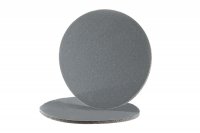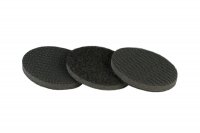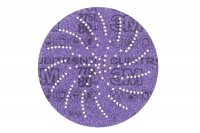Sanding discs for high stock removal rates or final fine sanding?
The choice of the right sanding disc depends largely on whether you need a high removal rate or a fine finish.
High removal rate:
If you need to remove a lot of material quickly, for example when removing old layers of paint or coarse sanding of raw materials, sanding discs with a coarse grit are the right choice. Coarse grits such as 40 or 60 are particularly effective at removing material quickly, but leave a rough surface with visible scratches. These sanding discs are often used in the initial stages of a project to prepare the surface for subsequent processing.
Final fine sanding:
Fine grit sanding discs are ideal for final sanding and preparing the surface before applying oil, wax or varnish. Fine grits such as 240 or higher produce a smooth surface and are perfect for the final processing steps. These discs ensure minimal material removal and perfect the finish by removing even the smallest imperfections and scratches.
Rigid or flexible application?
The decision of whether to use a rigid or flexible sanding disc depends heavily on the specific application and the requirements of the project.
Rigid sanding discs:
These are ideal for projects where a stable and even sanding surface is required. They offer a constant removal rate and are particularly suitable for sanding large, flat surfaces and for coarse sanding. A solid backing material such as plastic or metal ensures that the sanding disc retains its shape and exerts even pressure, resulting in uniform stock removal.
Flexible sanding discs:
These are ideal for applications where adaptability and surface protection are required. Sanding discs with a flexible backing material such as rubber or foam adapt better to irregular and contoured surfaces. They are particularly useful for sanding complex shapes, edges and hard-to-reach areas. Flexible sanding discs minimize the risk of damage and ensure an even finish, especially on delicate materials.
Open, semi-open or closed grit pattern?
The grit distribution of sanding discs influences the removal rate and surface quality:
Open grit pattern:
Here, the abrasive grains are further apart. This structure is ideal for soft materials and applications where the abrasive should not clog. Open grit distribution ensures a good removal rate with a lower risk of clogging, which is particularly advantageous when sanding wood. An example of this is the 3M 950U 17-hole velour Velcro blade, which is known for its efficient dust extraction and long service life.
Semi-open grit coating:
This coating is a compromise between open and closed grit coating. It offers a balanced removal rate and resistance to clogging and is well suited to materials that are not too soft and not too hard. The Kaef White 17-hole velour Velcro blade is an example of a semi-open grit pattern, which is particularly popular in woodworking.
Closed grit pattern:
Here, the abrasive grains are arranged close together. This structure is ideal for hard materials and applications where a smooth surface quality is required. Closed grit distribution offers a high removal rate and is particularly effective for fine sanding. One example of this is the Hermes Finet FN 915 Velours Klett flap disc, which achieves an outstanding surface quality.
Self-adhesive or with velour hook and loop backing?
Self-adhesive sanding discs:
These offer a simple and secure attachment that is sufficient for many applications. They are ideal for one-off applications or for situations where a quick change is not required. Self-adhesive sanding discs adhere directly to the sanding plate and provide a stable sanding surface. A disadvantage can be that removing the discs can leave residue that needs to be cleaned before a new disc can be applied.
Velcro backing:
Sanding discs with velcro backing make it quick and easy to change the discs. They are ideal for projects that require frequent changes between different grit sizes or sanding discs. The velcro backing ensures a secure attachment and can be removed without leaving any residue, which increases efficiency and flexibility. This type of attachment is particularly useful for longer sanding jobs and for applications where high precision is required.
Perforated or non-perforated sanding discs?
The choice between perforated and non-perforated sanding discs depends on the specific requirements of your project and the materials you want to process.
Perforated sanding discs:
These are equipped with a large number of holes that enable effective dust extraction during the sanding process. The holes allow the sanding dust to be extracted directly, which improves visibility of the work surface and extends the service life of the sanding disc as less dust accumulates. Perforated sanding discs are ideal for use in combination with sanding machines that have an integrated dust extraction system. They are ideal for large surfaces and for materials that generate a lot of dust, such as wood or drywall. One example would be the Hermes VC 154 Multiole Velours Klett sheet disc, which ensures efficient dust extraction thanks to its perforated structure.
Unperforated sanding discs:
These sanding discs have a continuous sanding surface without holes. They offer a larger sanding surface and can remove more material in less time as there are no interruptions due to holes. Non-perforated sanding discs are ideal for smaller projects or for use with sanders that do not have dust extraction. They are particularly useful for fine sanding and finishing surfaces where an even sanding surface is important. An example of a non-perforated sanding disc is the 150 Finet FN 915 Velour Velcro sheet disc, which provides an even surface for final sanding.
The choice between perforated and non-perforated sanding discs therefore depends on whether you need efficient dust extraction or prefer a larger sanding surface for fast material removal. Both types have their specific advantages and can be used depending on the project requirements.
Corundum grit, ceramic grit, silicon carbide or stearate coating?
The choice of abrasive grit has a significant influence on the performance and results of your sanding work. Different materials offer different properties and are suitable for different applications:
Corundum grit (aluminum oxide):
This grit is known for its hardness and toughness, making it ideal for general sanding work on metals and wood. It is particularly suitable for sanding alloyed and unalloyed steels as well as wood and plastics. Aluminium oxide grit ensures good stock removal and is a common choice for versatile applications.
Ceramic grit:
Ceramic grit is characterized by its exceptional hardness and toughness. It has the ability to self-sharpen during grinding, which extends its life and ensures consistently high grinding performance. Ceramic grit is ideal for hard materials and precision work, such as sanding high-strength steels.
Stearate coating:
Sanding discs with a stearate coating are particularly suitable for materials that are prone to clogging, such as resin-rich woods and lacquers. The stearate coating prevents the abrasive grains from clogging, which increases the efficiency and service life of the disc and ensures a uniform sanding pattern.
Silicon carbide:
This grain is extremely hard and brittle, which makes it ideal for sanding hard and brittle materials such as glass, stone, porcelain and ceramics. Silicon carbide is also excellent for sanding cast iron and non-ferrous metals. It produces a very fine finish and is often used in applications that require high precision.
Choosing the right abrasive grain depends on the material to be processed and the specific requirements of your project. Each grit offers unique advantages that can be optimally utilized for different sanding tasks.
For small or large surfaces?
Choosing the right sanding disc also depends on the size of the surface to be processed. Different projects require different disc sizes in order to work efficiently and precisely.
Small surfaces:
Sanding discs with a smaller diameter, such as 75 mm, are suitable for smaller surfaces or detailed work. These are ideal for precise work on small workpieces, edges and hard-to-reach areas. Smaller sanding discs allow for better control and fineness when sanding, which is particularly important for delicate materials or finishing work.
Large surfaces:
For larger surfaces and extensive sanding work, sanding discs with a larger diameter, such as 150 mm or 300 mm, are more suitable. These offer a larger sanding surface and enable faster processing of large surfaces. Large sanding discs are ideal for sanding floors, large pieces of furniture or wide metal plates, as they ensure even and efficient material removal.
Selecting the right sanding disc for the size of the surface to be worked on is a key factor in achieving efficient and professional sanding results.
Summary on the subject of sanding discs
Sanding discs are versatile tools that deliver different results depending on the grit, backing material and coating. Coarse grits are ideal for fast material removal, while fine grits ensure perfect fine sanding. Rigid sanding discs offer stability, while flexible sanding discs adapt to irregular surfaces. Perforated discs enable effective dust extraction, while unperforated discs offer a larger sanding surface. The choice of abrasive grain - whether corundum, ceramic, silicon carbide or stearate-coated - has a significant influence on performance and sanding results. Finally, the size of the sanding disc should be adapted to the surface to be processed in order to achieve optimum results. Our sales representative will be happy to answer any further questions you may have.
back to top... 
















